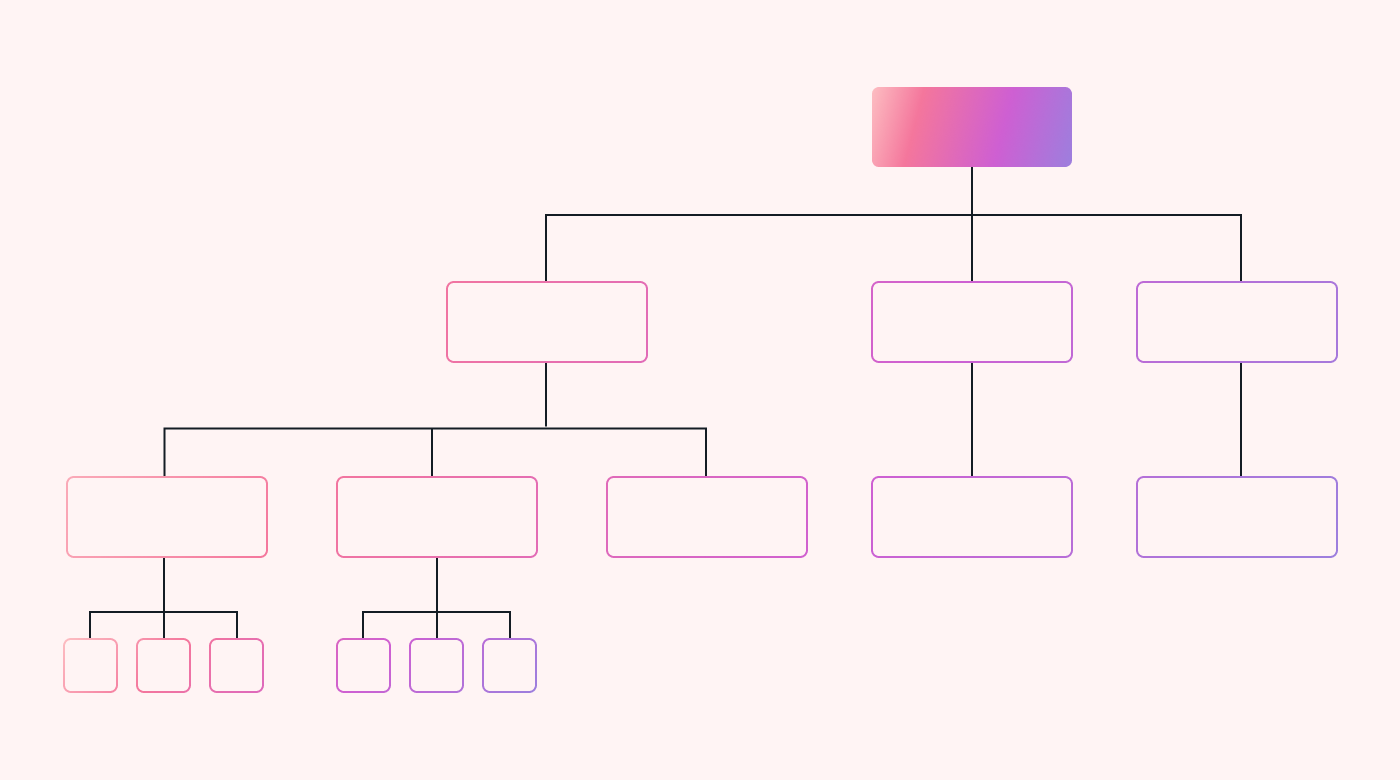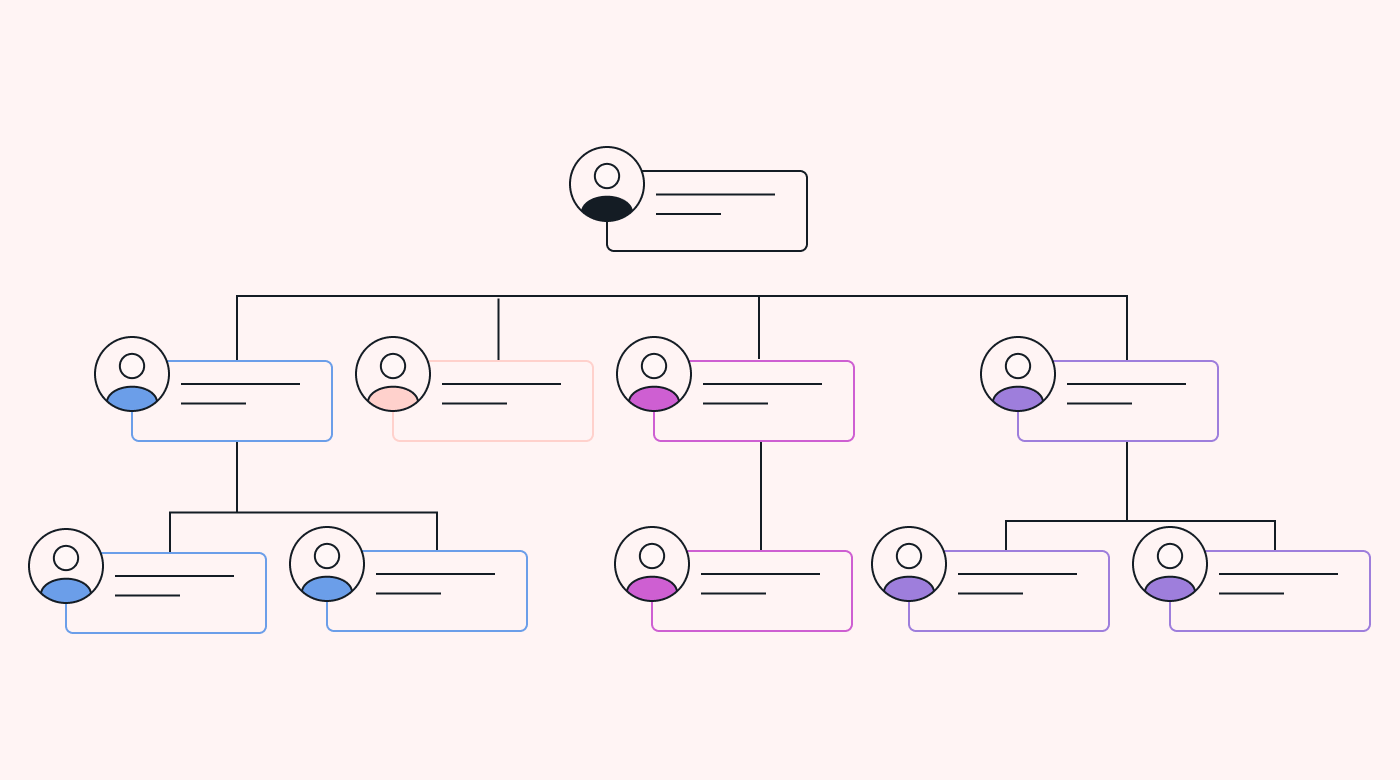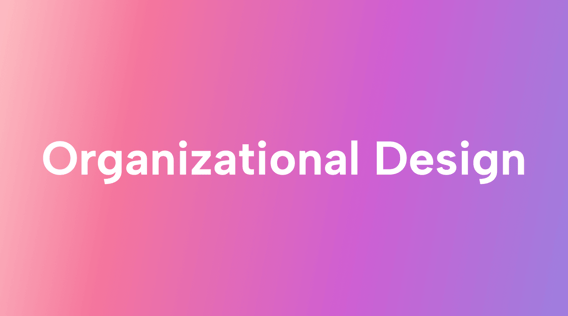When you start a new business, the only thing you’re usually looking at is the opportunity: how best to provide a product or service quickly and at a profit. You can do organizational design later and on an as-needed basis when your systems become stressed.
And there’s nothing wrong with that approach because change is the only constant in business and life. It means that organizational design isn’t something you do once. You have to do it every now and then just to adapt to changing market conditions. In a McKinsey survey, almost 60% of respondents said their organizations had experienced a redesign within the past two years.
It’d help to understand the different types of organizational structure you could choose. You’ll also want to know their pros and cons, and understand which is best for your business. But your first step should probably be understanding what organizational design is and what it isn’t.
What is organizational design?
Writing for the aptly named Center for Organizational Design. Dr. Roger K. Allen defines the concept as a “step-by-step methodology which identifies dysfunctional aspects of workflow, procedures, structures, and systems, realigns them to fit current business realities/goals and then develops plans to implement the new changes.”
That’s quite a mouthful, so let’s break it down into its simplest form. It’s a three-phase approach. First, you identify the problems. Then, you realign them with your business needs. And finally, you draw up plans to fix things.
Then, let’s add one more to that list. To make change happen, everyone in the organization needs to embrace it and adopt it.
Purpose of organizational design
The University of Southampton describes organizational development and design as a process to align the structure of a business with its objectives. The purpose of the exercise is to improve efficiency and effectiveness.
Interestingly, the university suggests that the word design isn’t strictly correct. This is because the process involves a lot more:
- Accepting the need for change and understanding the environment
- Fully grasping the business processes, workflows, roles and responsibilities, volumes of work, activity analysis, and resources
- Developing and testing new models or structures
- Creating a detailed plan for the transition and managing it
- Implementing the plan and monitoring the effects of the changes
Of course, such an all-encompassing process isn’t always necessary. Sometimes, all you need is a far more straightforward business process improvement exercise.
 |
Types of organizational design
As you may imagine, it’s not a one-size-fits-all thing. A structure that suits a service business wouldn’t necessarily work for a manufacturing company. There are four basic types of structure from which you can choose.
Functional structure
If you choose this structure, you’ll group people according to their specialist skills and knowledge. The focus is at a departmental level, each set up hierarchically with roles up and down the food chain.
Organizations structured this way typically contain specialized units. They all report to a single, centralized authority, usually called top management. Each unit focuses on only one aspect of the business, such as:
- Information technology
- Marketing
- Development
- Research
The advantage is that grouping similar skills and experiences can make production within each function more efficient and achieve higher quality. Your people can feel confident about what they're doing because it is standardized.
The main disadvantage is that each department is effectively a silo. This restricts the scope of work and growth of each silo and can cause poor communication between silos. It can harm teamwork and coordination across silos.
Horizontal structure
This type of structure is sometimes called flat because it has less hierarchy than other structures. Ideally, you'd have only a few chains of command in a business structured like this.
A horizontal structure has several advantages, one of which is more employee freedom. This lets your team members figure out the company's needs and steer themselves into that role. It helps organizational flexibility. With all your employees in the team, it can pivot or change direction to chase new opportunities.
Another advantage is that your business uses its resources more efficiently. With everyone on one team, it's easier to communicate, collaborate, and share resources.
But there is a downside. The structure doesn’t always scale well, especially in large organizations. In those environments, managers are reluctant to put what they see as too much control in the hands of team members.
 |
Matrix structure
This structure is a best-of-both-worlds approach. A matrix organizational structure combines the best parts of horizontal and vertical structures to improve collaboration and the allocation of resources.
The key to this structure is that it emphasizes cross-functional teamwork. The idea comes from the project management world, where individuals with diverse expertise come together to form a project team. Team members will often have dual reporting lines.
A matrix structure makes the most of specialized knowledge and helps communication. It also lets teams adapt to changing requirements and encourages them to use resources more efficiently.
This structure has two potential disadvantages. The first is potential role confusion because of multiple reporting lines and the different roles of team members. The second is about competing priorities that can create arguments over resources, deadlines, and objectives.
Divisional structure
In some ways, a divisional structure is similar to a functional structure, but instead of grouping people by their skills and roles, you’d group them based on the product or service they produce.
This structure is useful in large manufacturers or service providers with a lot of different products or services. General Electric is a great example. The company has units in electronics, transportation, and aviation. Each one is separate and has its own accounting, marketing, engineering and sales teams.
Another way to do it is by product line, as IBM used to do when it sold four distinct computer types: mainframe, midrange, workstations and PCs. Each was a business in its own right. You could also structure your divisions based on their geographic locations.
With a divisional structure, you still run into the silo effect found in a typical hierarchical structure. The advantages are focus, autonomy, and agility. The disadvantages are higher costs, duplicated effort, and trouble keeping consistent standards across all divisions.
Principles of organizational design
Span of control
This is also known as the control and commitment principle. You need to understand how many people your supervisors or managers can manage effectively. There’s no one-size-fits-all because there are too many variables.
It’s a difficult balancing act. You need to stay in control while keeping your team members engaged and committed. The best results come when control is aligned with responsibilities, is cost-efficient, and motivating for team members.
Chain of command
Every organization needs a formal line of authority, communication, and responsibility. This is the chain of command; your chosen structure will provide a basic framework. However, that should only be a guideline to adapt to get the best from your most valuable people.
 |
You can draw lines of authority on an organizational chart that shows relationships between people in your business. This makes duties and responsibilities clear to all.
Employee engagement and motivation
If you Google the subject, you'll find seven to 25 ways to improve engagement and motivation in your team. But every person is different, responds to different stimuli, and is motivated by different things.
But the one constant is that people don’t like being forced to change. So the obvious solution isn’t to force it on them but to involve them in understanding the need for it, and planning and implementing it.
External environment adaptation
The innovation and adaptation principle is another name for this concept. It’s all about how your business adapts to the changes around you. Whatever organizational structure you choose, it must be flexible enough to adapt to a world that changes all the time.
The right organizational design for you must help you and your team to visualize, develop, and roll out new strategies to manage these changes. You should also try to find some environmental stability and avoid too much complexity.
Decision-making processes and structures
As with your chain of command, your structure influences how decisions are made and how effective your processes are. Consider the impact of the CEO having to authorize spending on a $20 set of headphones. It wouldn’t be a good look.
The solution is to encourage data-driven decision-making. You can do this in your organizational design process by providing the systems and tools that enable it. And your strategy, environment, technology, organization size, and culture will all affect the details of how you do it.
Rinse and Repeat
The work is never done
Change is always with us and around us. It’s unavoidable and means that, every now and then, you need to anticipate or adapt to changing market conditions with structural changes in your business. Sometimes, you can get away with tweaking a business process here or replacing a workflow there. But at other times the change is too big and you have to look at your organizational structure again.
Triggers for revisiting your design
Three key triggers suggest a need for organizational design or redesign: a change in the environment, a change in strategy, or a current design that’s no longer fit for purpose.
Changes in the environment
This may be related to both internal and external changes. You might have spotted a new market or been taking a beating in an old one. You may have found some brilliant new technology to revolutionize your business or industry. A dangerous disease may be sweeping the world, forcing you to limit face-to-face contact with customers.
You may have encountered a new, more agile competitor or have to respond to changes in legislation or regulations in your industry. Any of these events, and many more, could prompt the need for changes to your organizational design and the way you operate.
You have a new strategy
You may have decided to adopt a new strategy for many reasons, including many of the environmental changes listed above. But the most common reason for a new strategy is that the old one isn’t working or isn’t working as well as you’d like.
The COVID-19 pandemic provided many examples of companies that needed a new strategy. Many restaurants were placed in this position by lockdowns and had to find a new strategy or close their doors.
Those who pivoted to internet-driven take-out operations are still around today but with different, more resilient business models. They had to redesign their organizational structure to achieve a new set of strategic goals.
Current design isn’t fit for purpose
Many changes around you and your business are gradual and only sometimes noticeable. But at some point, you’ll reach a tipping point where you know you must act. You may have begun your business with a very flat management structure, but as it grew, that became more unwieldy and difficult to control.
Or your rigid structure made it impossible for you to embrace the remote work phenomenon that exploded with COVID-19. As a result, you’ve been losing some of your best people to competitors, and you’re struggling to replace them because you can’t offer flexible working options.
 |
The answer is simple and complex at the same time: your organizational design must change to allow you to keep the talent you need to stay competitive and attract more.
Choosing the right design for you
Organizational design is about more than just structure and the need for it is increasing according to the McKinsey research. To the extent that the firm formulated nine golden rules for companies to better integrate their people, processes, and structures.
Or you could go it alone, in which case your first step is to assess your specific business needs and goals. You can then match those with the best organizational structure for you. There’s no right answer, and you may even choose a hybrid. The most critical thing is to find the best fit for your business and your team.
Move carefully, but move
Organizational design can be tricky, especially when solutions and systems that look very good on paper are less effective than you might have hoped. But the good news is that organizational design is an ongoing process, so you can always stop, re-evaluate, change course, and begin again.
Choosing a poor design is only irreversible if you double down when you should be calling for a new hand. And when you do embark on the redesign process, it’s helpful to monitor progress and stay on track to meet your design objectives. You can do this with electronic project management tools like Motion’s, with AI-enabled calendaring technology.





